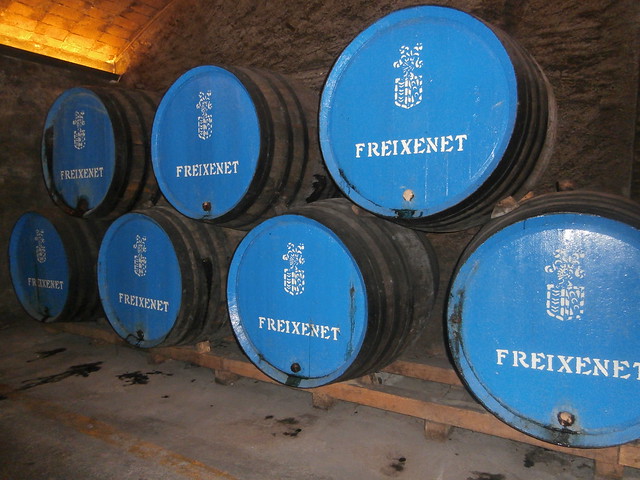Flyday Friday(The Wine Series): Cava
Helloooo!
So here it is, the second part of my wine series as promised. Cava is the name given to sparkling wines made in champenoise traditional method in Spain especially in the Penedés area of the Catalonian region. Cava in Catalan dialect means cave where the wines are usually aged in the olden times after fermentation and later the name refers to a cellar/s where the wines are stored in the modern times. But first here´s a picture of one of the major cava producers in Spain:

The type of grape usually used to produce cava are these three:

Cava production starts with the pressing of the grapes to produce the must:

The must or mosto in Spanish is also called grape juice. After the must is produced, the liquid is clarified and allowed to ferment.

Different types of grapes aare also added depending on the type of sparkling wine you are producing.

The special wines before bottling and second fermentation are stored also in oak barrels:


Then thay are bottled for the second fermentation but first, a photo. ;)
Cava bottles come in diiferent sizes and volume but they have the same shape:

After the first fermentation, the wine is bottled along with yeast and sugar and stoppered with a crown and placed sidewise or in a horizontal position. These are then allowed to ferment for a certain period of time or until there is sufficicient carbon dioxide formation, that´s where the bubbles came from. ;)

The Gran Reserva Real, the special cava used during the wedding of Prince felipe and Princess Letizia:

Later, after the second fermentation and to consolidate the lees at the neck of the bottle, the bottles need to be moved at certain angles.This process is called riddling can be done manually or mechanically:


The disgorging process when the wines are ready for consumption or have reached their ageing process and sugar level and bottled with a cork:

Cavas aside from being classified as Gran Reserva, reserva, etc. are also classified according to dryness( sugar, alcohol and tannin content. They are brut nature(without sugar added), brut, brut reserve, sec(dry), semi-sec(semi-dry) and dolsec( sweet). I´m tasting the brut and it was delicious and not too sweet! :)
I hope you´ve learned soemthing from this post. Enjoy your weekend, everyone!
Hugs,
Che
So here it is, the second part of my wine series as promised. Cava is the name given to sparkling wines made in champenoise traditional method in Spain especially in the Penedés area of the Catalonian region. Cava in Catalan dialect means cave where the wines are usually aged in the olden times after fermentation and later the name refers to a cellar/s where the wines are stored in the modern times. But first here´s a picture of one of the major cava producers in Spain:

The type of grape usually used to produce cava are these three:

Cava production starts with the pressing of the grapes to produce the must:

The must or mosto in Spanish is also called grape juice. After the must is produced, the liquid is clarified and allowed to ferment.

Different types of grapes aare also added depending on the type of sparkling wine you are producing.

The special wines before bottling and second fermentation are stored also in oak barrels:


Then thay are bottled for the second fermentation but first, a photo. ;)
Cava bottles come in diiferent sizes and volume but they have the same shape:

After the first fermentation, the wine is bottled along with yeast and sugar and stoppered with a crown and placed sidewise or in a horizontal position. These are then allowed to ferment for a certain period of time or until there is sufficicient carbon dioxide formation, that´s where the bubbles came from. ;)

The Gran Reserva Real, the special cava used during the wedding of Prince felipe and Princess Letizia:

Later, after the second fermentation and to consolidate the lees at the neck of the bottle, the bottles need to be moved at certain angles.This process is called riddling can be done manually or mechanically:


The disgorging process when the wines are ready for consumption or have reached their ageing process and sugar level and bottled with a cork:

Cavas aside from being classified as Gran Reserva, reserva, etc. are also classified according to dryness( sugar, alcohol and tannin content. They are brut nature(without sugar added), brut, brut reserve, sec(dry), semi-sec(semi-dry) and dolsec( sweet). I´m tasting the brut and it was delicious and not too sweet! :)
I hope you´ve learned soemthing from this post. Enjoy your weekend, everyone!
Hugs,
Che


Comments
♥